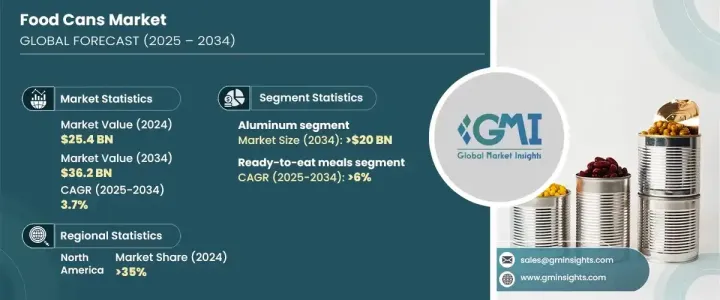PUBLISHER: Global Market Insights Inc. | PRODUCT CODE: 1684552

PUBLISHER: Global Market Insights Inc. | PRODUCT CODE: 1684552
Food Cans Market Opportunity, Growth Drivers, Industry Trend Analysis, and Forecast 2025-2034
The Global Food Cans Market reached USD 25.4 billion in 2024 and is projected to experience steady growth at a CAGR of 3.7% from 2025 to 2034. This upward trend is primarily driven by the increasing demand for shelf-stable packaging solutions, which offer both convenience and long-term storage benefits. Food cans provide multiple advantages, including durability, extended shelf life, and protection from contaminants, making them an ideal choice for maintaining food quality. As consumers continue to seek convenient, easily accessible food options, the food cans market is evolving to meet these needs, especially in an era where efficiency and convenience are paramount. Food cans play a vital role in the global food supply chain by ensuring that food products remain safe and fresh for an extended period, supporting consumer demand for high-quality, ready-to-eat meals.

The market is segmented by material type into aluminum and steel, with aluminum expected to dominate the industry. By 2034, aluminum cans are forecast to generate USD 20 billion, benefiting from their lightweight, durable, and recyclable nature. Aluminum's inherent properties, such as excellent barrier protection against light, air, and moisture, ensure food quality is preserved for extended periods. Additionally, aluminum's ease of shaping and reduced weight translate into lower transportation costs and more sustainable practices, helping to decrease carbon footprints across the supply chain. As sustainability initiatives become more widespread, the preference for aluminum over steel will likely grow.
| Market Scope | |
|---|---|
| Start Year | 2024 |
| Forecast Year | 2025-2034 |
| Start Value | $25.4 Billion |
| Forecast Value | $36.2 Billion |
| CAGR | 3.7% |
In terms of applications, the food cans market spans a variety of categories, including fruits and vegetables, meat and seafood, pet food, ready-to-eat meals, processed foods, and powder products. The ready-to-eat meals segment is anticipated to experience the highest growth rate, projected to reach a CAGR of 6% between 2025 and 2034. The surge in popularity of ready-to-eat meals can be attributed to a shift in consumer lifestyles, particularly among busy professionals and younger generations who prioritize convenience. With urbanization on the rise and disposable incomes increasing, canned ready-to-eat meals offer the perfect solution for modern lifestyles by providing long shelf life, easy storage, and minimal preparation time.
North America accounted for a significant 35% share of the global food cans market in 2024. The U.S. market is witnessing steady growth driven by various factors, including the rising demand for long-shelf-life, convenient food products. Canned food has gained traction for its role in emergency preparedness, as well as for meeting the needs of health-conscious consumers looking for easy-to-store, preservable food options. With a focus on enhancing convenience and accessibility, these trends will continue shaping the market growth trajectory in the coming years.
Table of Contents
Chapter 1 Methodology & Scope
- 1.1 Market scope & definitions
- 1.2 Base estimates & calculations
- 1.3 Forecast calculations
- 1.4 Data sources
- 1.4.1 Primary
- 1.4.2 Secondary
- 1.4.2.1 Paid sources
- 1.4.2.2 Public sources
Chapter 2 Executive Summary
- 2.1 Industry synopsis, 2022-2034
Chapter 3 Industry Insights
- 3.1 Industry ecosystem analysis
- 3.1.1 Factor affecting the value chain
- 3.1.2 Profit margin analysis
- 3.1.3 Disruptions
- 3.1.4 Future outlook
- 3.1.5 Manufacturers
- 3.1.6 Distributors
- 3.2 Key news & initiatives
- 3.3 Regulatory landscape
- 3.4 Impact forces
- 3.4.1 Growth drivers
- 3.4.1.1 Increase in shelf-stable packaging solutions
- 3.4.1.2 Rising demand for sustainable packaging
- 3.4.1.3 Growth in the ready-to-eat (RTE) food segment
- 3.4.1.4 Increasing demand for processed and canned foods
- 3.4.1.5 Technological advancements in can design
- 3.4.2 Industry pitfalls & challenges
- 3.4.2.1 Competition from alternative packaging
- 3.4.2.2 Fluctuating raw material prices
- 3.4.1 Growth drivers
- 3.5 Growth potential analysis
- 3.6 Porter's analysis
- 3.7 PESTEL analysis
Chapter 4 Competitive Landscape, 2024
- 4.1 Introduction
- 4.2 Company market share analysis
- 4.3 Competitive positioning matrix
- 4.4 Strategic outlook matrix
Chapter 5 Market Estimates & Forecast, By Material, 2021-2034 (USD Billion & Kilo Tons)
- 5.1 Key trends
- 5.2 Aluminum
- 5.3 Steel
Chapter 6 Market Estimates & Forecast, By Capacity, 2021-2034 (USD Billion & Kilo Tons)
- 6.1 Key trends
- 6.2 Less than 200 ml
- 6.3 200 ml to 500 ml
- 6.4 500 ml to 1000 ml
- 6.5 More than 1000 ml
Chapter 7 Market Estimates & Forecast, By Application, 2021-2034 (USD Billion & Kilo Tons)
- 7.1 Key trends
- 7.2 Fruits and vegetables
- 7.3 Meat and seafood
- 7.4 Pet food
- 7.5 Ready-to-eat meals
- 7.6 Processed food
- 7.7 Powder products
- 7.8 Others
Chapter 8 Market Estimates & Forecast, By Region, 2021-2034 (USD Billion & Kilo Tons)
- 8.1 Key trends
- 8.2 North America
- 8.2.1 U.S.
- 8.2.2 Canada
- 8.3 Europe
- 8.3.1 UK
- 8.3.2 Germany
- 8.3.3 France
- 8.3.4 Italy
- 8.3.5 Spain
- 8.3.6 Russia
- 8.4 Asia Pacific
- 8.4.1 China
- 8.4.2 India
- 8.4.3 Japan
- 8.4.4 South Korea
- 8.4.5 Australia
- 8.5 Latin America
- 8.5.1 Brazil
- 8.5.2 Mexico
- 8.6 MEA
- 8.6.1 South Africa
- 8.6.2 Saudi Arabia
- 8.6.3 UAE
Chapter 9 Company Profiles
- 9.1 Aaron Packaging
- 9.2 CANPACK
- 9.3 Colep Packaging
- 9.4 Crown Holdings
- 9.5 CPMC Holdings
- 9.6 Envases
- 9.7 Independent Can Company
- 9.8 Jamestrong Packaging
- 9.9 Kian Joo Group
- 9.10 Lageen Food Packaging
- 9.11 Massilly Holding
- 9.12 Nampak
- 9.13 Silgan Holdings
- 9.14 Sonoco Products
- 9.15 Toyo Seikan Group
- 9.16 Trivium Packaging
- 9.17 Visy Industries
- 9.18 Wells Can




